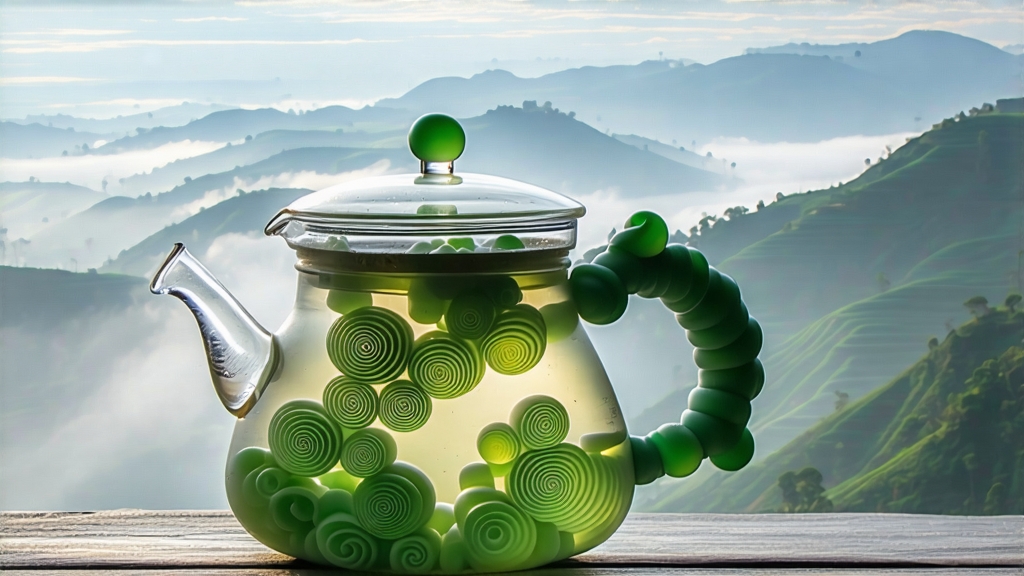
Tucked between the mist-laden slopes of East Dongting Mountain in Jiangsu Province and the vast, wave-whispering surface of Lake Tai, Biluochun—literally “Green Snail Spring”—has captivated Chinese tea lovers since the late Ming dynasty. Legend claims a nun found the bushes growing wild on a cliff in 1675; she brewed the leaves, was astonished by the perfume, and christened the tea “Scary Fragrance.” When the Kangxi Emperor tasted it on his southern inspection tour in 1699, he judged the name inelegant and rechristened it Biluochun to honor its tight spiral shape and early-spring harvest. Thus an imperial tribute tea was born, carried to the Forbidden City in bamboo-lined chests cushioned with orange peel to preserve its famously delicate bouquet.
Although Biluochun is a single famous name, the micro-climates and cultivars around Lake Tai create subtle regional styles. The original “Dongting West Mountain” version grows on thin, acidic granite soil at 200–300 m elevation, where daily lake mist filters sunlight and lengthens the budding period, concentrating amino acids. Across the water, Dongting East Mountain yields a slightly toastier cup because the slope faces the morning sun. Further away, low-elevation plantings in Sichuan and Zhejiang imitate the twisting technique but lack the floral complexity; purists label them “migration Biluochun.” Within the authentic core zone, two cultivars dominate: the small-leaf “Fuding” strain that gives pronounced fruit notes, and the “Dongting” strain whose downy buds exude orchid nuance.
The crafting of Biluochun is a race against dawn. Pickers climb the terraces at 4 a.m. when the air is still cool and the dew acts as a natural protective film around the tender one-bud-one-leaf sets. By 9 a.m. the baskets must reach the village workshop; after that, rising temperatures would oxidize the sap and flatten the fragrance. The first step is “killing green” (shaqing) in a drum pan fired to 180 °C. The tea master tosses 250 g of leaves at a time, using wrist flicks borrowed from wok cooking; within three minutes the moisture drops from 75 % to 55 % and the grassy enzymes are neutralized. Immediately the leaves are transferred to a worn elm board where three techniques—rolling (cuo), spiraling (tuan), and rubbing (mo)—are executed in seamless succession. The artisan presses the warm leaves against the wood with cupped palms, rotating clockwise 28 times, then counter-clockwise 28 times, repeating the cycle for ten minutes until the bud tips curl into tiny snail shells covered in silvery down. A final gentle bake at 60 °C for 30 minutes lowers the water content to 5 %, locking in the signature scent of peach, narcissus, and fresh water chestnut.
Because Biluochun is exceptionally delicate, water choice and temperature are non-negotiable. The classical prescription is “spring water at 80 °C, glass at 80 ml,” a mnemonic that pairs the mineral softness of mountain springs with a vessel that allows the foreign drinker to watch the ballet of downy spirals unfurling. If authentic Dongting spring water is unavailable, low-TDS bottled water filtered through activated carbon works; avoid hard tap water whose calcium will bind with catechins and dull the aroma. Pre-heat the glass with a quick rinse, then add 3 g of tea—about a heaping teaspoon—for every 80 ml. Pour the 80 °C water along the inner wall so the stream slides rather than crashes; within 20 seconds the buds sink, rise, and sink again, a motion tea poets call “the three floating three sinking.” Steep for 45 seconds on the first infusion, 30 on the second, and 50 on the third, extending gradually as the cellulose relaxes. A glass gaiwan can substitute for a beaker, but metal strainers are taboo; they bruise the leaf and add metallic overtones.
Tasting Biluochun is a vertical journey from fruit to flower to mineral. Bring the cup to lip level and inhale twice without sipping; the top note should evoke white peach skin and loquat. On the first sip, let the liquor rest on the tip of the tongue for two seconds—amino acids trigger umami akin to dashi. Swallow and close the mouth; a cooling sensation appears at the back palate, a phenomenon Chinese tasters call